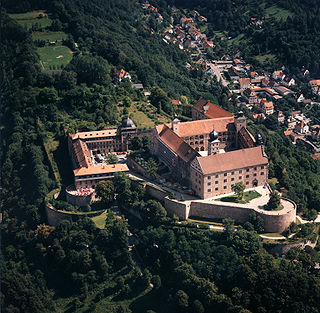
Ottokar I was Duke of Bohemia periodically beginning in 1192, then acquired the title of King of Bohemia, first in 1198 from Philip of Swabia, later in 1203 from Otto IV of Brunswick and in 1212 from Frederick II. He was an eminent member of the Přemyslid dynasty.
Wenceslaus I, called One-Eyed, was King of Bohemia from 1230 to 1253.

Hermann I, Landgrave of Thuringia and Count Palatine of Saxony, was the second son of Louis II, Landgrave of Thuringia, and Judith of Hohenstaufen, the sister of Emperor Frederick Barbarossa.

Plassenburg is a castle in the city of Kulmbach in Bavaria. It is one of the most impressive castles in Germany and a symbol of the city. It was first mentioned in 1135. The Plassenberg family were ministerial of the counts of Andechs and used as their seat the Plassenburg. The House of Guttenberg, a prominent Franconian noble family, traces its origins back to 1149 with a Gundeloh v. Blassenberg (Plassenberg). The name Guttenberg is derived from Guttenberg and was adopted by a Heinrich von Blassenberg around 1310. From 1340, the Hohenzollerns governed from Plassenburg castle their territories in Franconia till 1604. The Plassenburg was fortress and residence for the Hohenzollerns.

Henry III, called Henry the Illustrious from the House of Wettin was Margrave of Meissen and last Margrave of Lusatia from 1221 until his death; from 1242 also Landgrave of Thuringia.

Berthold IV, a member of the House of Andechs, was Margrave of Istria and Carniola. By about 1180/82 he assumed the title of Duke of Merania, referring to the Adriatic seacoast of Kvarner which his ancestors had conquered in the 1060s and annexed to Istria and Carniola.

The House of Henneberg was a medieval German comital family (Grafen) which from the 11th century onwards held large territories in the Duchy of Franconia. Their county was raised to a princely county in 1310.

Otto I, a member of the House of Andechs, was Duke of Merania from 1204 until his death. He was also Count of Burgundy from 1208 to 1231, by his marriage to Countess Beatrice II, and Margrave of Istria and Carniola from 1228 until his death.
Beatrice II reigned as Countess Palatine of Burgundy from 1205 until her death. She was a member of the Swabian Hohenstaufen dynasty, the daughter of Count Otto I of Burgundy and Margaret, Countess of Blois, thereby a granddaughter of Emperor Frederick Barbarossa.

The House of Andechs was a feudal line of German princes in the 12th and 13th centuries. The counts of Dießen-Andechs obtained territories in northern Dalmatia on the Adriatic seacoast, where they became Margraves of Istria and ultimately dukes of a short-lived imperial state named Merania from 1180 to 1248. They were also self-styled lords of Carniola.

Berthold III, a member of the Bavarian House of Andechs, was Margrave of Istria from 1173 until his death.

Henry I, a member of the House of Ascania, was Count of Anhalt from 1212 and the first ruling Anhalt prince from 1218 until his death.
The Duchy of Thuringia was an eastern frontier march of the Merovingian kingdom of Austrasia, established about 631 by King Dagobert I after his troops had been defeated by the forces of the Slavic confederation of Samo at the Battle of Wogastisburg. It was recreated in the Carolingian Empire and its dukes were appointed by the king until it was absorbed by the Saxon dukes in 908. From about 1111/12 the territory was ruled by the Landgraves of Thuringia as Princes of the Holy Roman Empire. When Frederick IV, the last independent ruler of Thuringia died in 1440, the territory passed to his nephew, the Saxon elector Frederick II.
Agnes of Merania was a member of the House of Andechs and an Austrian royal consort. By her two marriages, she was Duchess of Austria from 1230 until 1243 and Duchess of Carinthia from 1256 until her death.
Herman III, Count of Weimar-Orlamünde was a member of the Weimar-Orlamünde branch of the House of Ascania.
Beatrix of Merania was a princess of Merania by birth, and the Countess of Weimar-Orlamünde by marriage.
Siegfried III, Count of Weimar-Orlamünde was a member of the House of Ascania and a ruling Count of Weimar-Orlamünde.

Otto III. Weimar-Orlamünde, sometimes called Otto IV was a German nobleman. He was a member of the House of Ascania and a titular Count of Weimar-Orlamünde. He was the ruling Count of Weimar and Lord of Rudolstadt and Plassenburg.

Berthold II of Andechs, a member of the House of Andechs, was a German nobleman. He was a ruling count of Dießen and Andechs in the Duchy of Bavaria, of Plassenburg and Kulmbach in Franconia, as well as bailiff of Benediktbeuern Abbey.










